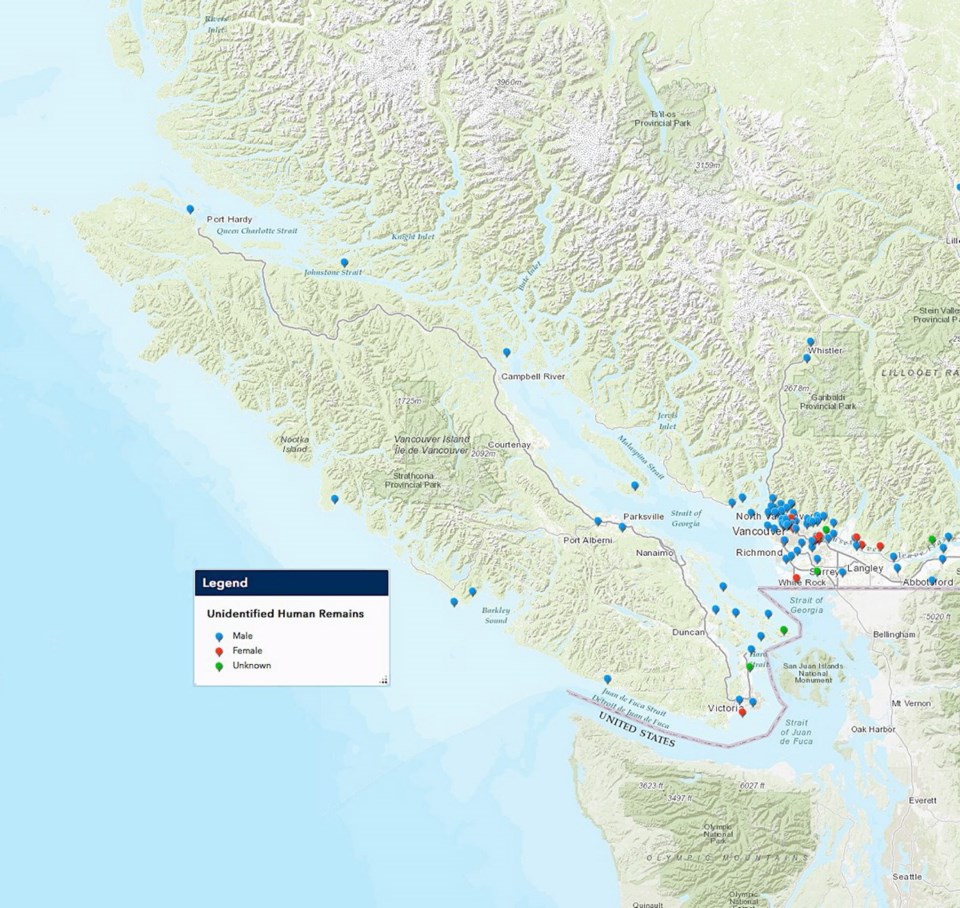From a long-sideburned man in Victoria to the bodies of two little boys found in Vancouver’s Stanley Park more than 60 years ago, each of British Columbia’s unsolved cases involving human remains has its place on a new interactive map.
B.C. Coroners Service spokesman Andy Watson said the goal is to generate new leads in the 200 unsolved cases, including five around Greater Victoria and 14 others on or near Vancouver Island. “The whole aim of this thing is to provide families with closure and bring answers to them,” Watson said.
Each entry on the map shows the approximate location where the remains were found, case numbers for contact purposes and a summary of key information related to each unresolved case.
The earliest file listed is the 1953 Babes in the Woods case involving two boys found dead in Stanley Park. The most recent case involves remains that were found last year.
Also on the list:
• The body of a man with long grey sideburns was found in Beacon Hill Park in 1988. Wearing a blue cotton waist-length jacket, blue shirt, blue pants and black loafers, he had been dead between two weeks and three months.
• The remains of a 40- to 70-year-old man found at Esquimalt Lagoon Dec. 30, 2008, were clad in black or blue corduroy pants, size 10 white Reeboks and black socks. He had been dead between two months and a year.
• The remains of a woman aged between 60 and 90 were found in the strait a couple of kilometres off Metchosin in January 1978.
• Isotope testing shows a man found by Ker Island east of Sidney in 2012 had been born after 1950. He had been dead between 10 and 50 years
• Also dead for that long was someone of unknown gender, aged between 60 and 75, found on the Saanich Peninsula in 1974. Whoever it was wore a gold watch, had dentures and had suffered from a disease of the spinal cord.
• Authorities hope a pair of distinctive running shoes will solve the mystery of two disarticulated feet found at Port Renfrew in February 2016. The feet were in a type of men’s size 12 black and blue New Balance shoes produced after March 2013.
Some cases come with very little information, such as a body of unknown sex or age found near 100 Mile House in 1983. The person was estimated to be between five-feet and five-feet-six inches tall and the body was likely there between 10 and 50 years before it was discovered.
Other cases are quite detailed, such as the body of a 30- to 40-year-old man found near Kamloops in 1983 with tattoos that say “Edna,” “Mary C,” “Love,” “Marlene,” and a crossed-out “Karene.”
A similar map exists in the United States, called the National Missing and Unidentified Persons System, but Watson said he believes this is a first for Canada.
“We know that nationally, there’s nothing in place that closely resembles this,” he said. “Longer term, the hope is that we can work with other provinces and get this into a national system.”
The map can be found on the B.C. Map Hub, hosted by the provincial government. It was created by the coroners service’s special investigations unit and a spatial information analyst.
Watson said the coroners service took the initiative on the project because its mandate is to answer the question of who died, as well as how, where, when and by what means.
“When we’re missing one of the answers to our five questions, from an investigation standpoint, we don’t feel our work is complete,” he said.
“For somebody in the public that’s thinking, ‘Oh, well maybe I have something to offer but I’m not sure,’ our message is, it may be that missing puzzle piece that links two or three other pieces together that we need to determine the identity.”



